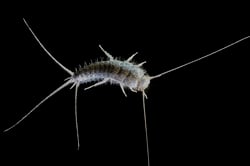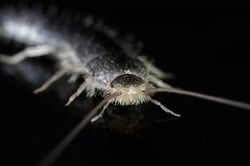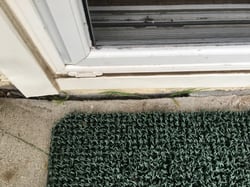Silverfish, also known as bristletails, typically seek out warm, damp, and humid habitats. While that may not sound like your home, in the chilly winter months, silverfish can become a lot more compromising in what they consider to be the perfect environment. As temperatures drop, many homeowners report a sudden influx of silverfish in their homes. While silverfish can technically survive freezing temperatures by entering a dormant state, many will flock to consistently well-heated environments (much like your temperature controlled home) where they can remain active all winter long. When this occurs, they can be exceptionally difficult to remove. Silverfish won’t leave your cozy home to brave the outdoor elements willingly – so how do you get rid of them?

What are silverfish?
Understanding silverfish is key in learning how to most efficiently (and successfully) remove them from your home.
Silverfish are thought to be one of the oldest insects in the world. Aptly named for their metallic silver appearance and fish-like movement, silverfish are small, wingless insects of the Zygentoma order. They have long antennae and a terminal filament at the base of their abdomen, both of which can be regenerated if lost in as little as two weeks. Silverfish are surprisingly hardy insects that are both agile and nocturnal, making them difficult to combat in the home. These insects can live for up to three years due in part to their ability to remain hidden and make swift escapes.
Craving humid environments, silverfish are abundant in many parts of the world, including Africa, America, Australia, Eurasia, and select regions of the Pacific. When inside the home, silverfish can thrive in a variety of areas and conditions. These insects are commonly found in attics, basements, bathtubs, showers, crawl spaces, and kitchens.
A silverfish’s diet consists largely of carbohydrates and some proteins. In their natural environments, they survive off mostly vegetable matter and other vegetation. Indoors, however, silverfish will eat virtually anything. Considered to be scavenger pests, silverfish consider nothing to be off-limits in your home. They will eat books, wallpaper, glue, insulation, and cardboard boxes in addition to practically everything in your pantry. Silverfish especially enjoy eating flour, sugar, rolled oats, rice, pasta, cereal, coffee, and even pet food. Your home is the perfect source of readily available food for a silverfish.

How do silverfish get inside my home?
Making their way into your home may be like winning the jackpot for a silverfish, but it’s a very different story for homeowners. Despite their minuscule size, silverfish can cause considerable damage to your home and belongings. Due to their voracious and nondiscriminatory appetites, silverfish will eat wallpaper right off your home's walls, devouring the pages of beloved family photo albums and biting holes through your clothing. They can also contaminate your food by leaving their feces behind.
But knowing the damage they can cause does nothing to prevent the entry of silverfish. And, unfortunately, silverfish can be pretty tricky to prevent!
Silverfish can enter your home in a variety of ways, as their small size allows them to squeeze through practically any opening. It’s suspected that many silverfish gain entry through cracks in your home’s foundation or slithering through damaged siding. They can also slip under doors with insufficient door sweeps. Gaps, where utilities enter the home, can also provide silverfish a potential entry route. In truth, a home with any small crack, gap, or crevice in its exterior (whether they’re aware of it or not) may be susceptible to silverfish.
 Crack in the foundation where silverfish can potentially enter.
Crack in the foundation where silverfish can potentially enter.
Why do silverfish come indoors?
In the fall and winter, plummeting temperatures can be a huge driving force that moves silverfish indoors. But silverfish are known to congregate in homes during the spring and summer too, suggesting they come indoors for reasons other than escaping the cold. So why might silverfish seek out your home year-round?
The primary reason silverfish enter homes is in search of food. Your home provides an endless supply of accessible food for silverfish, regardless of the time of year. Silverfish can count on your pantry remaining stocked as long as you’re living there. Food is always in the same place, always available, and always plentiful. It’s no surprise that silverfish on the hunt for food make their way into your home and never want to leave.
Silverfish may also be driven indoors during periods of dry heat when the soil they live in becomes void of dampness and humidity is nonexistent. In such cases, silverfish may seek out your crawl space or bathroom for adequate moisture.
Still yet, silverfish might be brought into your home accidentally. Silverfish can hitch a ride into your house when infested items are brought inside. This can sometimes happen when infested dry goods are brought indoors, boxes are moved inside, or firewood is carried in.
It should be noted that sometimes silverfish make an appearance when pipes burst or dehumidifiers fail. If you notice a sudden infestation of silverfish, it may warrant an inspection of your home’s utilities to ensure nothing has gone awry. The sudden appearance of silverfish, especially if you’ve never had a silverfish problem before, may be indicative of a larger issue.
 Silverfish may congregate in moist basements.
Silverfish may congregate in moist basements.
Can I prevent silverfish?
At EcoShield, we believe strongly that prevention is the best tool for keeping a home pest free. While there is no definitive way to prevent silverfish 100% of the time, there are precautions you can take to make your home more difficult to enter or less hospitable of an environment.
- Put dry goods in airtight glass or plastic containers.
- Recycle or throw out unneeded paper goods such as newspapers, magazines, mail, or paper bags.
- As an extra precaution, seal important documents in plastic sleeves or containers.
- Use dehumidifiers in basements, crawl spaces, attics, and even poorly ventilated bathrooms.
- Ensure your home ventilation systems are running efficiently and clean any associated filters.
- Seal cracks, gaps, or holes in your doors, windows, siding, and utilities.
- Employ the help of a trusted pest professional to provide routine maintenance and identify potential problem areas.
- Utilize professional pest prevention treatments around the exterior of your home.
- Use a pest professional that provides an egg cycle service to disrupt the silverfish life cycle and prevent any eggs from developing into adults.
 You can protect dry goods by storing them in sealed glass jars.
You can protect dry goods by storing them in sealed glass jars.
How do I get rid of silverfish in my home?
If you’re experiencing a current silverfish infestation in your home, we highly recommend you seek the expertise of a trusted pest professional such as EcoShield. Silverfish can be incredibly difficult to remove from your home, especially if there are a multitude of adults present and a new life cycle has likely begun. Infestations like this can occur quite easily as silverfish are nocturnal creatures, and homeowners may be unaware of their presence until it’s become out of control.
There are a multitude of DIY options for removing silverfish, however we caution against this. While DIY solutions may appear successful, this is often only temporary. In instances of infestation, you may succeed in killing off adult silverfish, but silverfish eggs will likely remain. These eggs will develop into nymphs and, soon after, adults. You’ll likely have to treat again for the same problem, and thus the neverending cycle begins.
Additionally, ridding yourself of the existing silverfish is only half the battle. Though the insects may be gone, it’s crucial you address the conditions of your home that resulted in the silverfish infestation. If you don’t identify and rectify the root cause of silverfish entering your home, you’ll probably find yourself with another infestation in the future.
It is for these reasons that we strongly recommend you contact a reputable pest professional at the first sight of an infestation. With EcoShield’s Home Protection Plan, we not only remove the existing silverfish infestation, but we also disrupt the silverfish lifecycle and address target locations in your home to prevent future infestations. This service protects you not only from silverfish but a multitude of other creepy crawlies that frequently enter homes.
If you’re struggling with a silverfish infestation, call us or fill out the form on this page for a free no obligation quote. EcoShield is here to protect you and your home from silverfish, and many other residential pests, 100% guaranteed.